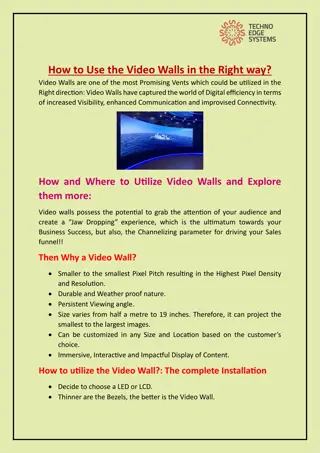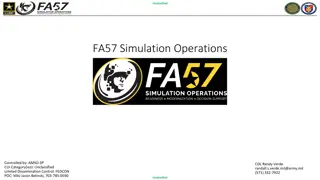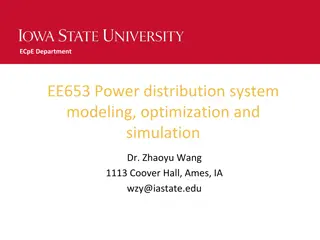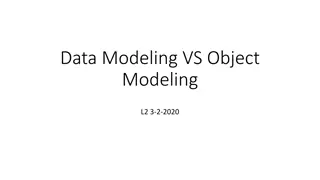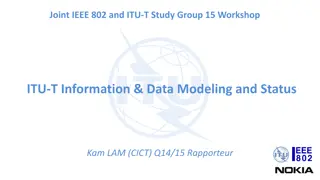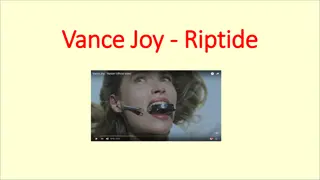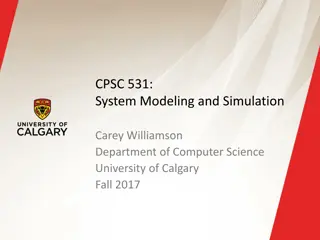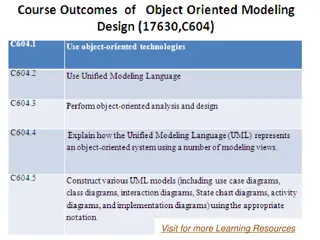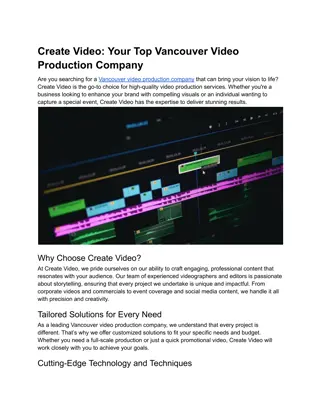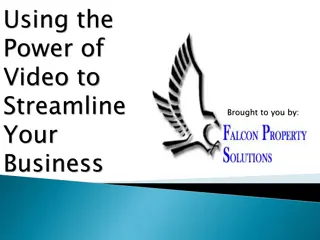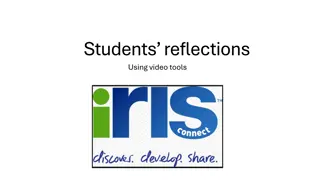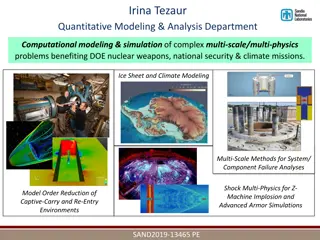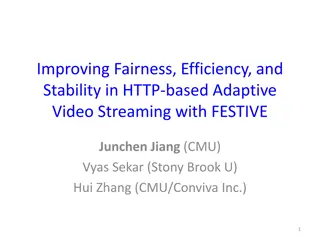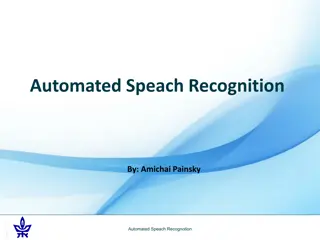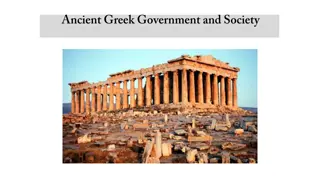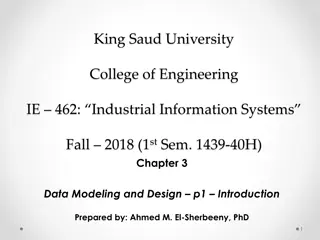The Benefits of Video Modeling in Education
Video modeling is a powerful tool used in education to teach skills in a structured and visual manner. It helps teachers, staff, and families deliver instruction consistently and effectively, benefiting learners of all ages and developmental levels. The approach is particularly useful for students with Autism Spectrum Disorder (ASD) and can be adapted to suit various learning environments, including teletherapy settings. Research supports the efficacy of video modeling in enhancing skill acquisition and promoting independence in learning.
Download Presentation

Please find below an Image/Link to download the presentation.
The content on the website is provided AS IS for your information and personal use only. It may not be sold, licensed, or shared on other websites without obtaining consent from the author.If you encounter any issues during the download, it is possible that the publisher has removed the file from their server.
You are allowed to download the files provided on this website for personal or commercial use, subject to the condition that they are used lawfully. All files are the property of their respective owners.
The content on the website is provided AS IS for your information and personal use only. It may not be sold, licensed, or shared on other websites without obtaining consent from the author.
E N D
Presentation Transcript
What Is Video Modeling? A way to teach a skill either through broken down individual steps or in a sequential order to students A way to teach staff and/or families how to teach, how to prompt, and how to remain consistent when teaching a student a certain task or skill A tool for staff and families to identify and learn how and what correct responses should look like Potential way to teach adaptive alternatives to staff for future problem solving for their students (I can explain what I mean if you want) Potential way to increase speed and efficiency of performing an activity/task Tool for teachers to use in order to increase student learning Tool for Parent Coaching/Training Tool for staff training Pre-Recorded Video (3 possible types/perspectives) Visual Model of desired behavior
Prerequisite Skills Motor Imitation- Just because 18- year-old can t imitate, should we be teaching in context instead? Really looking at imitation tasks as functional not only tapping table or touching nose Consider age appropriateness of task being modeled (too complex or detailed?) Attention to video (if student only attends for 5 seconds do not start with 15 step TA) Vision, Hearing, Reading skills, operating technology (help determine format of video potentially) Imitation skills Teachers edit those imitation to targets to be more functional
Who Can Benefit? Everyone and Anyone! (I think that sums it up! All ages All dev. levels Promotes staff teaching the same way to do a task (consistency) Takes place in natural environment where skill is to be used Students with ASD often need increased time to complete or Helps with consistency of skills especially during times of teletherapy and now with social distancing factors when working with one another )
Student Skill Acquisition Self hep skills Leisure Skills Task Analysis Activities Daily Living/Life Skills Social Skills Academics Vocational skills Community skills Play Home Exercise Programs/Fitness Routines
Staff Training Data input procedures Lesson plan implementation Prompting Procedures Adaptive/Alternative ways to complete/perform a task or step How to teach error correction procedures General Modeling showing what the staff should be doing during student routine (Perspective of student AND showing STAFF appropriate behavior
Parent Training Behavior Interventions/Training Lesson Plan Implementation Prompting procedures Examples of correct response/performance of activities and tasks Ways to generalize skills learned at school in home or in community
How To Implement Video Modeling Tolerating, de-sensitizing, not for reinforcement Introduction of new task analysis/lesson plan (for staff) When student has demonstrated skill at home and want parents to begin implementing/generalizing at home (for parents) While performing a task (pause between each step) When performing a task (continue play and student performs with video) Prior to performing a task
Basic Video Modeling (BVM) Learner watches a video of an actor other than himself Actor appropriately demonstrates a specific skill or routine The learner then has the opportunity to imitate what was seen in the video Relies on use of a spectator view
Basic Video Modeling (BVM) Academic Example Leisure Example Motor Example Communication Example Domestic Example Community Example
Video Self-Modeling (VSM) Involves the learner watching a video of themselves successfully demonstrating the target skill or routine The learner then has the opportunity to imitate what was seen in the video Relies on use of a spectator view
Video Self-Modeling (VSM) Academic Example Leisure Example Motor Example Communication Example Domestic Example Community Example
Point Of View Video Modeling Involves recording a person engaging in the specific skill or routine Video captures *** exactly what the learner will see through their own eyes while performing the skill or routine
Point Of View Video Modeling Academic Example Leisure Example Motor Example Communication Example Domestic Example Community Example
Video Prompting (VP) Involves showing a video clip of one step of the task and then giving the learner the opportunity to complete that step before the next step is shown Can be used with a spectator view or POV
Video Prompting (VP) Replaying certain clip/time One task video- work on individual step in isolation vs. entire task Develop Hierarchy of Prompting (Staff) Revision Ideas/Adaptation Ideas- meet with team Fading Prompts What not to do vs. what to do videos and guidelines BLOOPER VIDEOS
(Wertalik & Armstrong, 2020) 2. Create Task Analysis and Data Sheet 3. Collect BSL Data and Set Step Mastery Criteria 1. Selecet and Define Target Skill 4. Create and Edit Videos 5.Carry out VM with students 6. Fading of Video modeling (Wertalik & Armstrong, 2020)
1. Select and Define Target Skill Movement cycle: Observable, repeatable contains movement Steps to create movement cycles: 1. Select observable action verb 2 .Add s to end of action verb (present tense) 3. Identify relevant object (always singular) (Kubina & Yurich, 2012) Movement Cycle plus Context = Pinpoint Pinpointing- Directly identifies clear, observable targeted actions or movements
3. Collect BSL Data and Set Step Mastery Criteria Behavioral Fluency ( The fluid combination of accuracy plus speed that characterizes competent performance (Binder, 1996)
4. Create and Edit Videos Decide which perspective/type of video model to use (if self-modeling or video prompting, decide if you are going to use a spectator perspective or the point of view perspective) Prepare outline/script and practice making video to ensure you are including what and how you want made as wel as identify best environment for activity/video Identify best video recording equipment available If possible, remove/limit unwanted noise or materials Split video into steps if wanting to teach in this way
6. Fading of Video modeling Fading of Video modeling Examples-chunking, time delay, delete scenes (forward or backward chaining) *Where to discuss correction procedures, prompting procedures, and providing reinforcement during video?
Microsoft Teams App **iPad accessible- Movie editor? How are we getting them to parents? (Email will not allow for video size) Send through Microsoft Team? Parent Resources- upload INTERNAL VIDEO CLEARANCE


